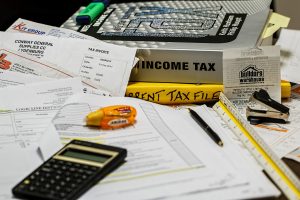It’s that time of year, friends, when one of the only two certain things in life looms large: taxes.
As a kid, April 15 was a holiday in our house. It was the day my accountant mother could breathe again after over 3 long months of helping her clients. I may have learned a thing or two along the way, so I’m happy to share some tips on how to get organized before heading to your accountant’s office, or, if you’re one of those brave souls who tackles the task on your own, before you sit down at the kitchen table amid a sea of paperwork. In either case, the key is starting early… as in January 1 early.

Taxes can get pretty complicated depending on what kind of return you have to file. Do you have a business? Dependents? Itemized deductions? There are already a lot of great sources of information out there about which documents and information you need to gather. Instead, let’s focus on how to move through this year proactively so that when April 2020 rolls around, you won’t be scrambling to find all this documentation.
Start a System
The first thing you should do is have a dedicated folder where you can file any paperwork that you may need come next April.
- Create folders for:
- Tax Documents
- Personal Receipts
- If you are self-employed, you should create additional folders for:
- Business Documents
- Business Receipts
Execute the System
Know which documents you need to keep in each folder and make lists. If you need help with this, your tax preparer should be able to help you create a customized list based on how you file and the specifics of your financial architecture. Otherwise, here’s a great general resource: https://www.rgbrenner.com/resources/what-do-i-bring-to-my-tax-appointment/
Attach these lists to the front of each folder. Cross off items as they go into the folder.
Documents come in all year, so this is a great way to keep yourself informed at a glance. A few notes:
- Things like property taxes may show up early in the year.
- Income statements start arriving in the mail or your inbox in January.
- Some personal receipts worth saving are:
- Records of cash donations to religious institutions, schools & other charities
- Records on non-cash charitable donations
- Unreimbursed job-related expenses (e.g., travel, tools, cell phone charges, uniform cost/cleaning, luggage, services fees, trade journals, meals & entertainment)
- Job search/moving expenses¹
- For your business, you’ll want to save receipts for EVERYTHING, such as:
- Advertising
- Equipment & supplies
- Meals & travel
- Continuing education & professional development
- Books & research materials
- Dues & memberships
- Subscriptions
Maintain the System
Now that you’re filing, try to stay ahead of the record-keeping by doing it monthly. This effort will help both you and your accountant simplify the process come March or April, so you don’t have to scramble to collect all the information and dollar amounts in a last-minute rush.
Pick your poison to start an electronic or written file for keeping records of expenses. I’m a lover of Excel, but some folks prefer Word or even handwritten lists. If you’re in the latter camp, I recommend buying a dedicated ledger book to record line items. Keep separate files for personal and business. Once a month, go through your saved receipts and enter them into your record. Remember to categorize the type of expense for each receipt.
————
As you can see, it’s all about establishing a system that you can easily maintain throughout the year with minimal effort. It’s so easy to get behind with all the personal and professional obligations we balance. If we can stay aligned with the system and find an hour a month to maintain it, then when that April 15 holiday inevitably rolls around again, we can face it head-on with confidence and careful preparation.
¹ https://www.rgbrenner.com/resources/what-do-i-bring-to-my-tax-appointment/




